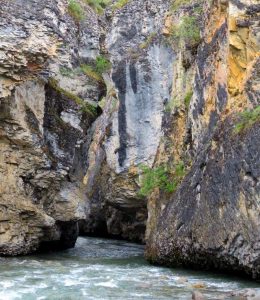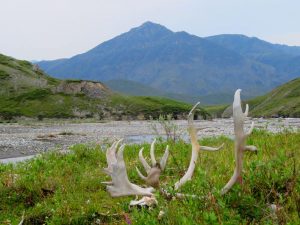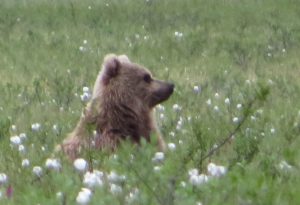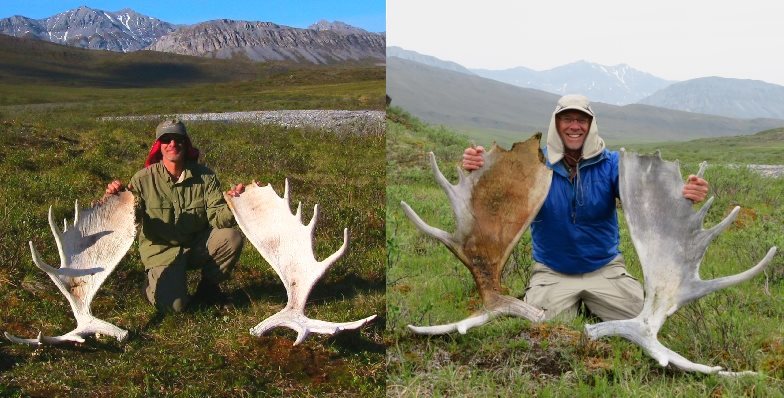July 6
Sometime during the night it began to rain. When I wake up I hear it pattering on my shelter; I stall for an hour but the rain persists. I sit up, trying not to touch the wet silnylon inches over my head. It’s not quite freezing as I pack, rainwater dripping off the hood of my rain jacket.
I sling on my pack and carefully look around to make sure I haven’t forgotten something. I straighten up and adjust my pack. Clouds are hanging low over wet mountains that are completely indifferent to my existence.
I pull on my waterproof mitten shells and head downstream, following a tributary of the Kongakut to the main stem of the river. I can smell the wet tundra. Cold water is coming at me from every direction: from the sky, from the willow bushes, from the soggy ground , into my running shoes. I often hear people argue that rain gear is largely pointless because if you’re working hard you’ll eventually get wet anyway. But although I’m getting wet around my wrists and neck and legs, I’ll stay mostly dry, and my rain gear makes a huge difference in warmth. I can’t wait until I run into some hot summer weather, a clear sunny day in the 80s or low 90s.
Rocky bluffs begin rising along the little creek. I’m trudging along when I spot a little cave a few feet away. Just inside, on a nice dry spot, is a snowshoe hare. He looks at me, seemingly reluctant to run out into the cold rain. I hike on, leaving him to enjoy his dry refuge.
A bit later I find a rock overhang with dry tundra beneath it. I sit down, completely protected from rain. Predictably, the rain stops almost immediately. I win either way. I hike on.

Rock walls close in on the creek until it becomes a slot canyon. I’m tempted to wade down it but I know from experience that I’m likely to encounter deep water with no way around. I look at my GPS map and decide to hike cross-country to the main fork of the Kongakut.
I follow a tundra covered hillside up the mountain until the ridge flattens out. There’s a nice view of the main river. This is the first time on this trip that I’m seeing familiar ground. I walked down the main Kongakut for many miles on my Brooks Range Traverse, which my route this summer will overlap by several miles.
Today there is definitely some mushy walking but there is good walking as well. The rain has stopped. You know how shortcuts tend to turn into long-cuts? Well this one really was a shortcut, saving me at least two miles. I walk out onto a dry gravel bar of the Kongakut and sit on a big rock to peel off my rain pants. I treat some water then dig into my food bag to get something to eat.

It’s pleasant hiking up the Kongakut River. There are gravel bars and easy fords across shallow water. I follow trails through willows. In almost no place am I struggling. I walk along a big tundra meadow covered with cotton grass. I am nearly certain this is where I saw a sow grizzly and two cubs on my Brooks Range Traverse.

There is something out in the meadow that looks suspiciously like a grizzly. I walk up on a slightly higher spot. Yup! A young grizzly, busily digging up roots. After a while he sits down in the cotton grass and looks around with a look of contentment. Eventually he stands up and wanders away, feeding as he goes.
Next to a tundra knoll on a distant hillside a white dot scampers around. I sit down and pull out my monocular but the dot disappears for good. It was likely a white wolf puppy that’s run back into it’s den.
I frequently see shed moose antlers. This is a moose migration route between this border area of Alaska and the Yukon Territory. I’m enjoying the scenery when I look down to see two large moose antlers lying side by side. I know these antlers because I have held these very antlers in my hands before, on my 2006 [east/west] Brooks Range traverse. A thousand+ miles for each trip and here are the same antlers, in one of the most remote spots in America! People who know me well know how much I enjoy coincidences, how cool I think it is when paths intersect in interesting ways. After twelve years I pose once more with these impressive, heavy antlers. It’s doubly interesting because when I first found them they were lying together like this. There is little doubt they were shed within moments of each other by an old bull moose. Rarely are matching antlers found side by side. [When I get home I look at my 2006 photos and am delighted to see the same mountains in the background.]

Today there are a few mosquitoes out. What is truly hard to believe is that I have only been bitten ONCE by a mosquito on this trip up until today! Usually there are swarms of mosquitoes on the North Slope this time of year, but summer is coming late.
I follow a tributary of the Kongakut southward, away from my 2006 route. A lone, young caribou bull trots towards me, hoping I am part of a herd. But alas, he finds that I’m not even a caribou. He follows me curiously for a way nonetheless. I realize that after the river of caribou yesterday, this is the only caribou I’ve seen all day. This might be the last caribou I’ll see this summer.
When the tributary forks once more I find a nice campsite on a flat, dry, tundra bench. I am only a few miles from the Continental Divide, and about 45 miles from my first cache. I have hiked nearly 140 miles so far, averaging nearly twenty miles a day.
I haven’t seen another human in a week.


Hey bucktrak. I found this site inadvertantly. I must have hit the facebook button. I don’t use it.
However I I’ll try to read your entire hike.
Ugonna go to Rodney’s ?
Hi Nemo!
Glad you found it, even if it was inadvertent. I’m not going to Dow’s this year. How about you? Did you and Al get all your work done on the farm?
Buck